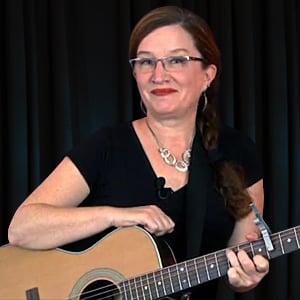Description
Let’s see if we can apply the same concept to the D major chord.
First, let’s review the D major scale, naming the notes by their number (1, 2, 3, etc.).
Now, let’s apply the recipe for the major triad.
We’ll take note #1(D), note #3(F#), and note #5(A).
Uh-oh, we can’t play all three of these notes at once, in that order, in this chord form, like we could with the C and the G chords.
But that’s ok.
The triad tells us what ingredients we need, but remember, the order in which the ingredients appear does not matter at this point.
Just so long as they all make an appearance. So, we need D’s, F#’s, and A’s, to prove that this is indeed a fully qualified D Major chord.
Let’s go through the chord, and map it out. 4th string open, is a D. 3rd string, 2nd fret, is an A. 2nd string, 3rd fret, is another D. 1st string, 2nd fret, is an F#.
Bingo! We got it! All the notes come from the major triad, even though they can’t necessarily be played in that order.
